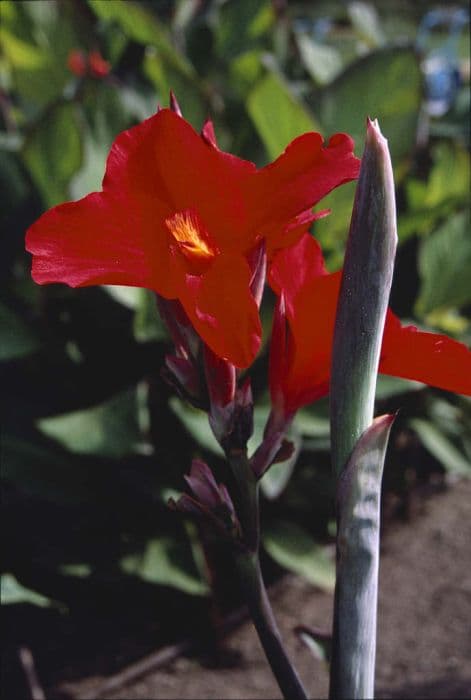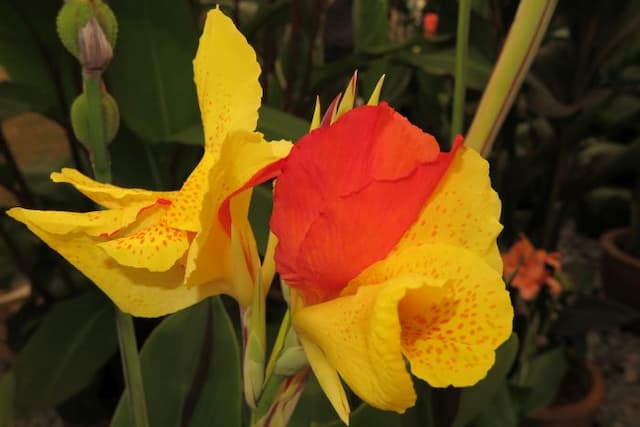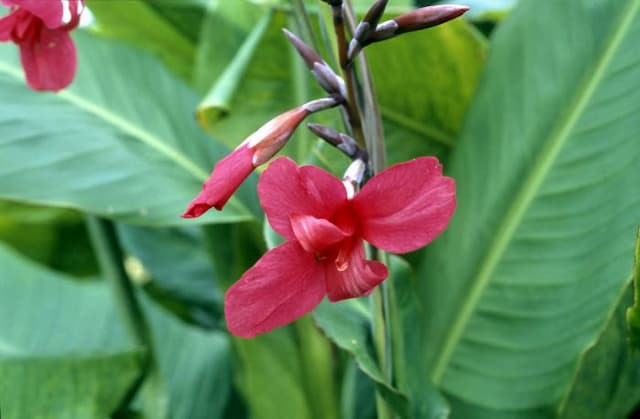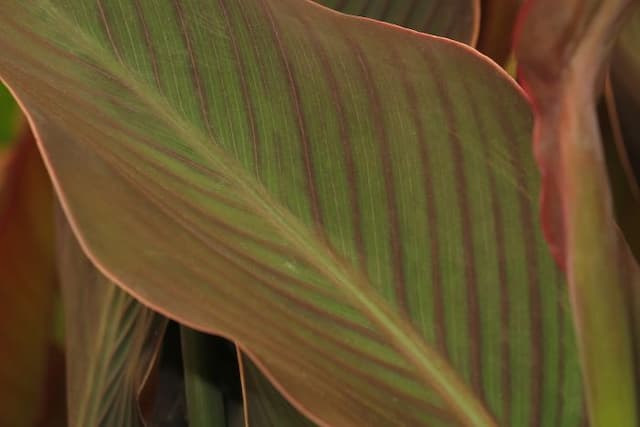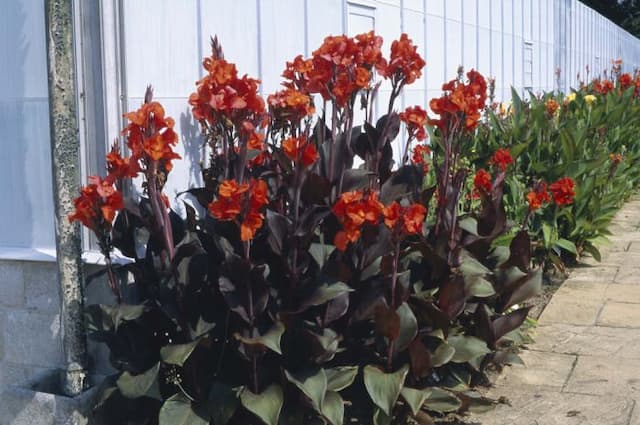Canna Lily Canna 'Richard Wallace'

ABOUT
Canna 'Richard Wallace' is a strikingly beautiful garden plant known for its bold, lush foliage and vibrant flowers. The leaves of this Canna are broad and wavy, featuring a rich green color that can sometimes have a hint of blue-grey undertones. Its foliage presents a tropical look and forms a clump, which serves as the backdrop for its showy blooms. The flowers of Canna 'Richard Wallace' are its most captivating feature. They bloom in a bright yellow hue with delicate speckles of orange or red, typically sporting a soft sheen that glimmers in the sunlight. These flowers are large and resemble an iris in shape, with flared and ruffled petals that add a touch of elegance to the plant's visual appeal. Clustered atop sturdy stems which rise above the foliage, the flowers of Canna 'Richard Wallace' are a favorite among gardeners for their ability to attract hummingbirds and butterflies, contributing to the overall liveliness of gardens where they are planted. The plant exudes a lush, tropical ambiance and adds a splash of color to any landscape where it is grown.
About this plant
 Names
NamesFamily
Cannaceae.
Synonyms
Canna Lily, Canna, Indian Shot, Arrowroot.
Common names
Canna 'Richard Wallace'.
 Toxicity
ToxicityTo humans
Canna Lily plants, including the 'Richard Wallace' variety, are not known to be toxic to humans. They do not contain substances that are harmful if ingested in small quantities. However, as with any plant, individual reactions can vary, and it is generally not advisable to consume ornamental plants due to potential gastrointestinal discomfort or allergic reactions. If large amounts are ingested, one should seek medical advice, but typically no severe toxicity is expected from Canna Lilies.
To pets
Canna Lily plants, inclusive of the 'Richard Wallace' cultivar, are not considered toxic to pets, such as cats and dogs. They do not contain significant levels of toxic compounds, and ingestion of the plant material usually does not lead to severe poisoning. However, some pets may experience mild gastrointestinal upset if they consume large amounts of the plant. Close observation for any signs of distress is recommended, and if symptoms appear aggravated, consultation with a veterinarian would be prudent.
 Characteristics
CharacteristicsLife cycle
Perennials
Foliage type
Deciduous
Color of leaves
Green
Flower color
Yellow
Height
4-5 feet (1.2-1.5 meters)
Spread
1.5-2 feet (0.45-0.60 meters)
Plant type
Bulb
Hardiness zones
7
Native area
South America
Benefits
 General Benefits
General Benefits- Aesthetic Appeal: Features striking foliage and vibrant yellow flowers that add color and visual interest to gardens.
- Habitat Support: Attracts pollinators such as bees and butterflies, promoting biodiversity.
- Easy Maintenance: Known for being low-maintenance, requiring minimal care once established.
- Durability: Tolerates heat and is relatively resistant to pests and diseases.
- Versatility: Suitable for use in borders, containers, and as a focal point in floral displays.
- Fast-Growing: Quickly reaches maturity, providing a rapid impact on landscaping projects.
- Erosion Control: Can be used to help prevent soil erosion due to its robust root system.
 Medical Properties
Medical PropertiesThis plant is not used for medical purposes.
 Air-purifying Qualities
Air-purifying QualitiesThis plant is not specifically known for air purifying qualities.
 Other Uses
Other Uses- Canna 'Richard Wallace' leaves can be used to create a bold, tropical themed fabric print for clothing or home decor, mimicking its lush green foliage and vibrant flowers.
- The large leaves of the Canna can serve as natural biodegradable platters or wrappers for serving food in eco-friendly gatherings.
- Due to its height and dense foliage, Canna can be planted as a privacy screen in gardens or patios to provide secluded areas.
- The dried seed pods of Canna can be used in crafting, such as in making musical shakers or as an addition to homemade potpourri.
- The robust stalks of the plant can be repurposed as natural garden stakes for supporting other less sturdy plants.
- Canna's richly colored flowers can be used in the art of pressing flowers, and then utilized in creating handmade paper or bookmarks.
- The Canna can be planted in large containers to create moveable garden features that can be rearranged for different landscaping looks.
- With its attractive foliage, Canna can be used as a backdrop for photographing smaller plants or garden features, enhancing their visibility and appeal.
- The fibrous material of the Canna plant can be explored as a sustainable material for making bio-composite plastics or papers.
- Canna leaves can be used to add a tropical flair to themed events or parties, serving as table runners or natural decor elements.
Interesting Facts
 Feng Shui
Feng ShuiThe Canna is not used in Feng Shui practice.
 Zodiac Sign Compitability
Zodiac Sign CompitabilityThe Canna is not used in astrology practice.
 Plant Symbolism
Plant Symbolism- Fiery Love - The vibrant, often reddish flowers of the Canna symbolize intense passion and deep feelings.
- Confidence - With their large, showy blooms, Cannas are often associated with a sense of boldness and self-assuredness.
- Pride - The Canna's stature and impressive presence in a garden can represent pride and accomplishment.
- Creativity - Because of their exotic appearance, Canna flowers are linked to creativity and artistic flair.
- Power - The robust growth and dominant appearance of Cannas can be seen as a symbol of power and dominance in a garden setting.
 Water
WaterCanna Lilies, including the 'Richard Wallace' variety, should be watered to keep the soil consistently moist but not waterlogged. During the growing season in spring and summer, this may translate to watering once or twice per week, depending on the climate and weather conditions. It is best to provide them with about 1 to 1.5 inches of water per week. Use a gentle watering method, such as a drip system or a watering can, to avoid disturbing the soil or damaging the foliage. In hotter, drier periods, increase the water frequency to ensure the soil doesn't dry out, as Cannas prefer a moist environment.
 Light
LightCanna Lilies thrive in full sun, meaning at least 6 to 8 hours of direct sunlight per day. Position the 'Richard Wallace' variety in a spot where it receives unfiltered sunlight to promote optimal growth and flowering. They can tolerate some partial shade, especially in hot climates, but too much shade can lead to leggy plants with fewer blooms.
 Temperature
TemperatureCanna Lilies are best suited to warm temperatures and will flourish when daytime temperatures are between 70°F and 90°F. They can survive minimum temperatures of about 55°F, but frost can damage the plants. Ideally, ensure that 'Richard Wallace' Canna Lilies are not exposed to temperatures below this range to prevent harm to the plant.
 Pruning
PruningPrune Canna Lilies to remove spent flowers and seed pods throughout the growing season to encourage further blooming. Cutting back the foliage in late autumn or after the first frost is also recommended to tidy up the plants and prepare them for winter. In climates without frost, pruning can occur in late winter before new growth starts. Dead or damaged leaves should be removed as they appear to maintain plant health and appearance.
 Cleaning
CleaningAs needed
 Soil
SoilCanna lilies prefer a well-draining, fertile soil mix with a good amount of organic matter. A mix containing loamy soil, compost, and a small amount of sand for drainage can work well. Aim for a soil pH between 6.0 and 6.5, which is slightly acidic to neutral.
 Repotting
RepottingCanna lilies generally need to be repotted every 2 to 3 years or when they become root-bound. Overwintered rhizomes should be repotted in spring before new growth begins.
 Humidity & Misting
Humidity & MistingCanna lilies thrive in moderate to high humidity levels; however, they are adaptable and can tolerate the humidity levels typically found outdoors in their growing regions.
 Suitable locations
Suitable locationsIndoor
Provide bright light, warm temperatures, and keep soil moist.
Outdoor
Full sun, rich soil, water regularly, fertilize monthly.
Hardiness zone
7-10 USDA
 Life cycle
Life cycleCanna 'Richard Wallace' begins its life cycle when a rhizome segment is planted and germinates to produce shoots. The shoots grow into sturdy stems with broad, lance-shaped leaves, and the plant develops into a mature Canna lily, reaching up to 4-5 feet in height. During the summer months, the Canna lily produces bright yellow flowers that attract pollinators and can continue blooming until the first frosts of autumn. After flowering, seed pods may form, which can be collected for propagation or left to self-seed. As temperatures drop in the fall, the foliage begins to die back and the plant enters a period of dormancy. During this dormant phase, the rhizomes can be left in the ground in warmer climates or lifted and stored in cooler areas to protect them from freezing, to then be replanted the following spring, continuing the cycle.
 Propogation
PropogationPropogation time
Spring-Early Summer
The Canna 'Richard Wallace', commonly referred to as Canna Lily, is best propagated through division, which is the process of separating the rhizomes. This method is commonly carried out in the spring, just before the growing season begins when the soil has warmed up to at least 55°F (about 13°C). Gardeners should carefully dig around the plant to lift the rhizome clump out of the ground, ensuring minimal damage to the roots. Using a sharp knife, the clump is then divided into sections, each with at least one eye, or growth point. The divisions are then replanted into well-draining soil at a depth of about 4 inches (10 cm), spaced approximately 1 to 2 feet (30 to 60 cm) apart to allow for adequate growing room.

